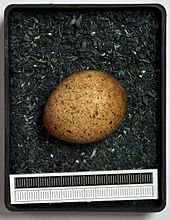Tree falcon
| Tree falcon | ||||||||||||
|---|---|---|---|---|---|---|---|---|---|---|---|---|

Tree falcon ( Falco subbuteo ) |
||||||||||||
| Systematics | ||||||||||||
|
||||||||||||
| Scientific name | ||||||||||||
| Falco subbuteo | ||||||||||||
| Linnaeus , 1758 |
The tree falcon ( Falco subbuteo ) is a small falcon, the most noticeable feature of which is its rust-red "pants" (leg plumage and under tail coverts). It is the second most common species of falcon in Germany, after the kestrel and before the peregrine falcon . The inventory trend is down.
description
The tree falcon is between 30 and 36 cm long and has a wingspan between 70 and 85 cm, the female is larger than the male. They reach a weight of 140 to 350 grams. The top is dark slate gray, the underside with streaky spots. The cheeks are white with a distinct streak of beard. In flight it is reminiscent of an oversized common swift with narrow, pointed, sickle-shaped wings and a relatively short tail.
Distribution area
The tree falcon is distributed almost over the whole of Europe (British Isles: only southern England, Scandinavia: only southern and Baltic Sea area), large parts of North and Central Asia , northern China to Kamchatka , Sakhalin and Japan .
The European population winters in southern Africa, the Asian in northern India and Pakistan as well as in southern China.
Subspecies
- Falco subbuteo subbuteo L., 1758
- Falco subbuteo streichi Hartert and Neumann, 1907 - China (smaller than subbuteo )

habitat
The tree falcon breeds in woods, groups of trees or on the edges of forests. Light pine trees are preferred, clumps are less often found in other coniferous trees (light spruce trees , in the south pine trees ), deciduous or alluvial forests . It is important to adjoin suitable hunting areas, i.e. spacious, open and varied landscapes. For the breeding, mainly old (due to the late breeding season often also this year), high-standing crow nests with free approach are used. In some areas, high-voltage pylons, solitary and avenues of deciduous trees are used.
At migration time, the tree falcon can be observed in almost all habitats, and it is particularly fond of hunting for dragonflies and insect-eating small birds in bodies of water .
Annual rhythm
The tree falcon returns to Germany from its wintering areas in April. The breeding grounds are occupied from May to early June. The courtship takes place with loud calls and with conspicuous flight maneuvers. From the beginning of June, the female lays 2–3 eggs, less often 1 or 4 eggs. The young birds hatch after a breeding period of 28 days. After about a month the young birds leave the nest and fly out a little later. The families leave their territories in mid-August to early September and, from the end of September, embark on the migration to the African winter quarters, which lie south of the equator and reach as far as South Africa.
Annuals moult in summer, otherwise moulting takes place mainly in winter.
voice
The typical call consists of a high, pointed “kikiki”, which can usually be heard in a long, faster and then slower call series. It usually sounds a bit muffled, so a calling bird often seems more distant than it actually is. There are a large number of other vocalizations, e.g. B. the so-called Lahnen , a soft “gjii” that can also be heard during courtship.
Hunting style and diet
The way the tree falcon hunts differs significantly from that of the slightly larger kestrel. He is an open-air hunter who prey on insects , especially beetles and flying ants , by gliding and gliding . Dragonflies are an important source of food, especially in water and moorland . To his diet but also includes small birds such as larks ( "Lerch Falcon"), chokes or finches and he is even capable of swallows and swifts to capture the steep sloping or shock.
In the African winter quarters flying termites form its main diet.
Duration
The total population of the tree falcon is estimated at 71,000 to 120,000 breeding pairs at the beginning of the 21st century. The main distribution area is Russia, where between 30,000 and 60,000 breeding pairs occur. The population in Germany is between 2,700 and 3,000 breeding pairs, in Austria between 800 and 1,200 breeding pairs and in Switzerland between 400 and 600 breeding pairs. In the Red List of Germany's breeding birds from 2015, the species is listed in Category 3 as endangered.
supporting documents
literature
- Hans-Günther Bauer, Einhard Bezzel and Wolfgang Fiedler (eds.): The compendium of birds in Central Europe: Everything about biology, endangerment and protection. Volume 1: Nonpasseriformes - non-sparrow birds. Aula-Verlag Wiebelsheim, Wiesbaden 2005, ISBN 3-89104-647-2 .
- Dietrich Fiuczynski: The tree falcon . Neue Brehm-Bücherei, Vol. 575. A. Ziemsen Verlag. Wittenberg Lutherstadt 1988, ISBN 3-89432-229-2
- Benny Génsbol, Walther Thiede; Birds of prey - All European species, characteristics, flight images, biology, distribution, endangerment, population development , BLV Verlag Munich, 1997, ISBN 3-405-14386-1
- Theodor Mebs : Birds of prey in Europe. Biology. Existing conditions. Existence risk. Kosmos nature guide. Stuttgart, 1989, ISBN 3-440-05990-1
Web links
- Falco subbuteo in the endangered Red List species the IUCN 2008. Posted by: BirdLife International, 2008. Accessed on December 18 of 2008.
- Videos, photos and sound recordings on Falco subbuteo in the Internet Bird Collection
- Recordings from the great outdoors at www.fokus-natur.de
- Age and gender characteristics (PDF; 5.7 MB) by J. Blasco-Zumeta and G.-M. Heinze (eng.)
- Feathers of the tree falcon
Single receipts
- ↑ Tree Falcon. Retrieved August 20, 2017 .
- ↑ Bauer et al., P. 357
- ↑ Christoph Grüneberg, Hans-Günther Bauer, Heiko Haupt, Ommo Hüppop, Torsten Ryslavy, Peter Südbeck: Red List of Germany's Breeding Birds , 5 version . In: German Council for Bird Protection (Hrsg.): Reports on bird protection . tape 52 , November 30, 2015.


